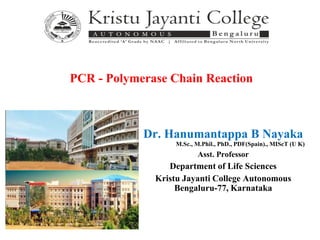Pcr
- 1. Dr. Hanumantappa B Nayaka M.Sc., M.Phil., PhD., PDF(Spain)., MIScT (U K) Asst. Professor Department of Life Sciences Kristu Jayanti College Autonomous Bengaluru-77, Karnataka PCR - Polymerase Chain Reaction
- 2. PCR - Polymerase Chain Reaction ŌĆó PCR is an in vitro technique for the amplification of a region of DNA which lies between two regions of known sequence. ŌĆó PCR amplification is achieved by using oligonucleotide primers. ŌĆō These are typically short, single stranded oligonucleotides which are complementary to the outer regions of known sequence. ŌĆó The oligonucleotides serve as primers for DNA polymerase and the denatured strands of the large DNA fragment serves as the template. ŌĆō This results in the synthesis of new DNA strands which are complementary to the parent template strands. ŌĆō These new strands have defined 5' ends (the 5' ends of the oligonucleotide primers), whereas the 3' ends are potentially ambiguous in length.
- 6. Primer selection ŌĆó Primer is an oligonucleotide sequence ŌĆō will target a specific sequence of opposite base pairing (A-T, G-C only) of single-stranded nucleic acids ŌĆó For example, there is a ŌĆō ┬╝ chance (4-1) of finding an A, G, C or T in any given DNA sequence; there is a ŌĆō 1/16 chance (4-2) of finding any dinucleotide sequence (eg. AG); a ŌĆō 1/256 chance of finding a given 4-base sequence. ŌĆó Thus, a sixteen base sequence will statistically be present only once in every 416 bases (=4 294 967 296, or 4 billion): this is about the size of the human or maize genome, and 1000x greater than the genome size of E. coli.
- 7. Primer Specificity ŌĆó Universal ŌĆō amplifies ALL bacterial DNA for instance ŌĆó Group Specific ŌĆō amplify all denitrifiers for instance ŌĆó Specific ŌĆō amplify just a given sequence ŌĆó Forward and reverse primers ŌĆó If you know the sequence targeted for amplification, you know the size which the primers should be anealing across ŌĆó If you donŌĆÖt know the sequenceŌĆ” What do you get?
- 8. DNA Polymerase ŌĆó DNA Polymerase is the enzyme responsible for copying the sequence starting at the primer from the single DNA strand ŌĆó Commonly use Taq, an enzyme from the hyperthermophilic organisms Thermus aquaticus, isolated first at a thermal spring in Yellowstone National Park ŌĆó This enzyme is heat-tolerant ŌåÆ useful both because it is thermally tolerant (survives the melting T of DNA denaturation) which also means the process is more specific, higher temps result in less mismatch ŌĆō more specific replication
- 9. RFLP ŌĆó Restriction Fragment Length Polymorphism ŌĆó Cutting a DNA sequence using restriction enzymes into pieces ŌåÆ specific enzymes cut specific places Starting DNA sequence: 5ŌĆÖ-TAATTTCCGTTAGTTCAAGCGTTAGGACC 3ŌĆÖ-ATTAAAGGCAATCAAGTTCGCAATAATGG Enzyme X 5ŌĆÖ-TTC- 3ŌĆØ-AAG- Enzyme X 5ŌĆÖ-TTC- 3ŌĆØ-AAG- 5ŌĆÖ-TAATTT 3ŌĆÖ-ATTAAA 5ŌĆÖ-CCGTTAGTT 3ŌĆÖ-GGCAATCAA 5ŌĆÖ-CAAGCGTTAGGACC 3ŌĆÖ-GTTCGCAATAATGG
- 10. RFLP ŌĆó DNA can be processed by RFLP either directly (if you can get enough DNA from an environment) or from PCR product ŌĆó T-RFLP (terminal-RFLP) is in most respects identical except for a marker on the end of the enzyme ŌĆó Works as fingerprinting technique because different organisms with different DNA sequences will have different lengths of DNA between identical units targeted by the restriction enzymes ŌĆō specificity can again be manipulated with PCR primers
- 11. Electrophoresis ŌĆó Fragmentation products of differing length are separated ŌĆō often on an agarose gel bed by electrophoresis, or using a capilarry electrophoretic separation












